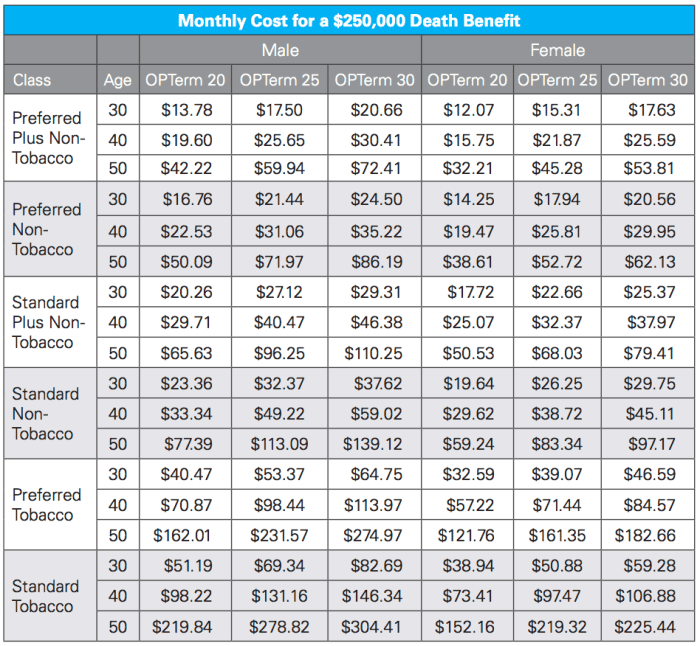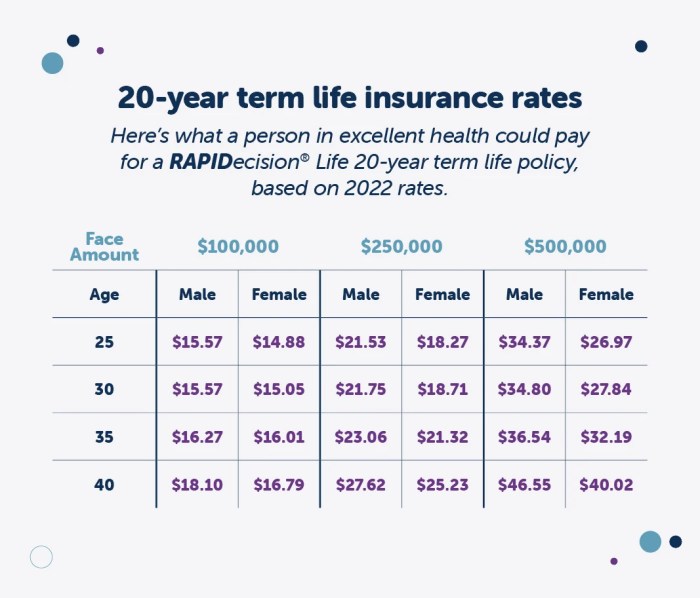The search for the best life insurance rates can feel overwhelming, a maze of policies, premiums, and jargon. But understanding the key factors that influence your cost is the first step towards securing affordable and adequate coverage for your loved ones. This guide navigates the complexities of life insurance, empowering you to make informed decisions and find the best fit for your individual needs and budget.
We’ll explore the various types of life insurance – term, whole, universal, and variable – comparing their costs, benefits, and suitability for different life stages and financial goals. We’ll also delve into how factors like age, health, lifestyle, and family history impact your premiums, offering practical strategies for optimizing your rates and potentially saving money.
Factors Affecting Individual Rate Quotes

Securing the best life insurance rates involves understanding the key factors influencing your individual quote. Insurance companies assess a range of personal details to determine your risk profile and subsequently, the premium you’ll pay. This assessment considers your health, family history, and lifestyle choices.
Health Information Requested by Insurance Companies
Insurers typically request comprehensive health information to accurately assess your risk. This commonly includes details about your current health status, any pre-existing conditions, past medical history, surgeries, hospitalizations, and current medications. They may also ask about your height and weight to calculate your Body Mass Index (BMI), a key indicator of overall health. Furthermore, questions regarding tobacco use, alcohol consumption, and drug use are standard, as these factors significantly impact longevity and health outcomes. Providing accurate and complete information is crucial for obtaining an accurate quote and avoiding potential complications later.
Impact of Pre-existing Conditions on Life Insurance Rates
Pre-existing conditions, such as diabetes, heart disease, or cancer, can significantly increase your life insurance premiums. The impact depends on the severity and stability of the condition. For example, a well-managed, stable case of type 2 diabetes might result in a moderate premium increase, whereas a recently diagnosed, aggressive form of cancer could lead to a substantial increase or even denial of coverage. Insurers assess the likelihood of the condition impacting your lifespan and adjust premiums accordingly. Individuals with pre-existing conditions may find it beneficial to explore different insurance providers to compare quotes and find the most suitable coverage.
Influence of Family Medical History on Premium Costs
Your family medical history plays a crucial role in determining your life insurance rate. A family history of heart disease, cancer, or other serious illnesses increases your perceived risk. This is because genetic predisposition can increase your likelihood of developing similar conditions. For example, if several close relatives have died from heart attacks before the age of 60, your premium might be higher than someone with a family history free of such conditions. Insurance companies use this information, along with your personal health information, to create a holistic picture of your risk profile.
Medical Examination Process for Life Insurance
Many life insurance applications require a medical examination as part of the underwriting process. This typically involves a brief physical examination conducted by a physician or nurse chosen by the insurance company. The exam usually includes taking your blood pressure, weight, height, and blood and urine samples. These samples are tested for various health markers, such as cholesterol levels and glucose levels. The results of this examination, combined with the information provided on your application, help the insurer assess your overall health and determine your eligibility and premium rate. While the specifics of the exam can vary based on the insurer and the amount of coverage sought, the overall goal is to obtain objective medical data to support the risk assessment.
Conclusive Thoughts

Ultimately, securing the best life insurance rates involves a careful balance of understanding your needs, researching available options, and actively engaging in the process. By understanding the factors that influence premiums, comparing quotes from multiple providers, and considering the long-term implications of your choice, you can confidently select a policy that provides adequate protection without unnecessary financial strain. Remember, proactive planning and informed decision-making are key to securing a financially secure future for yourself and your family.
FAQ Explained
What is the difference between term and whole life insurance?
Term life insurance provides coverage for a specific period (term), typically 10, 20, or 30 years, at a fixed premium. Whole life insurance provides lifelong coverage with a cash value component that grows over time, but premiums are generally higher.
How often are life insurance premiums reviewed?
This depends on the type of policy. Term life insurance premiums are typically fixed for the policy term. Whole life insurance premiums may remain level throughout the policy’s duration or adjust based on the policy’s design. Universal life premiums are often adjustable, allowing for flexibility.
Can I get life insurance if I have a pre-existing condition?
Yes, but your premiums may be higher. Insurers will assess your health status and consider pre-existing conditions when determining your rate. It’s crucial to be upfront and honest about your health history during the application process.
What happens if I miss a life insurance premium payment?
Most policies have a grace period, typically 30 days, before the policy lapses. If payment isn’t made within the grace period, the policy may lapse, and coverage will end. However, you may be able to reinstate the policy under certain conditions.